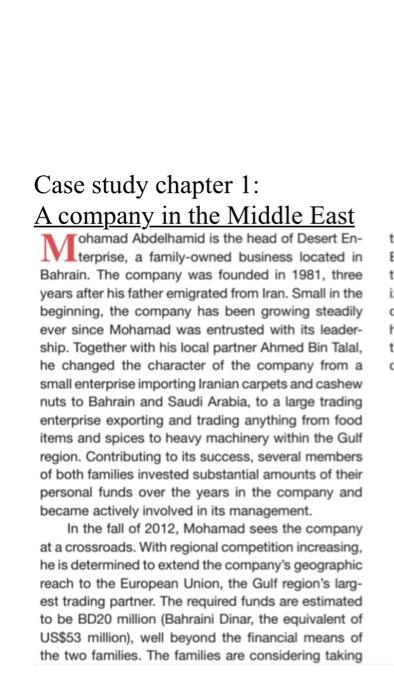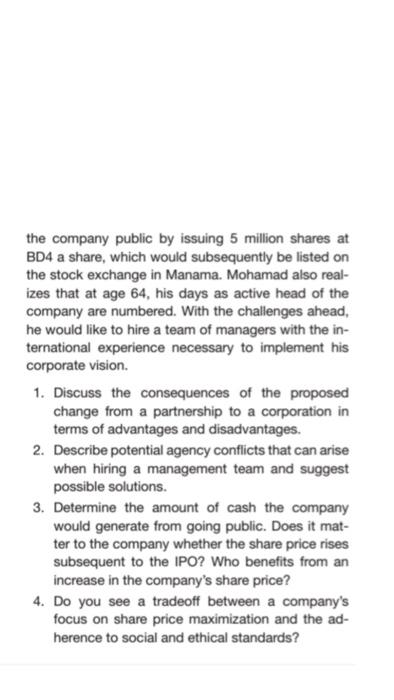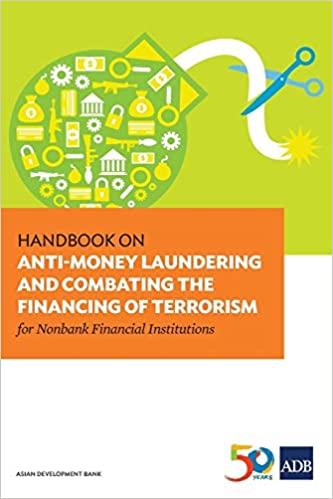read the case carefully and answer each question thoroughly.

t E t t Case study chapter 1: A company in the Middle East ohamad Abdelhamid is the head of Desert En- , in Bahrain. The company was founded in 1981, three years after his father emigrated from Iran. Small in the beginning, the company has been growing steadily ever since Mohamad was entrusted with its leader- ship. Together with his local partner Ahmed Bin Talal, he changed the character of the company from a small enterprise importing Iranian carpets and cashew nuts to Bahrain and Saudi Arabia, to a large trading enterprise exporting and trading anything from food items and spices to heavy machinery within the Gulf region. Contributing to its success, several members of both families invested substantial amounts of their personal funds over the years in the company and became actively involved in its management. In the fall of 2012, Mohamad sees the company at a crossroads. With regional competition increasing, he is determined to extend the company's geographic reach to the European Union, the Gulf region's larg- est trading partner. The required funds are estimated to be BD20 million (Bahraini Dinar, the equivalent of US$53 million), well beyond the financial means of the two families. The families are considering taking the company public by issuing 5 million shares at BD4 a share, which would subsequently be listed on the stock exchange in Manama. Mohamad also real- izes that at age 64, his days as active head of the company are numbered. With the challenges ahead, he would like to hire a team of managers with the in- ternational experience necessary to implement his corporate vision. 1. Discuss the consequences of the proposed change from a partnership to a corporation in terms of advantages and disadvantages. 2. Describe potential agency conflicts that can arise when hiring a management team and suggest possible solutions. 3. Determine the amount of cash the company would generate from going public. Does it mat- ter to the company whether the share price rises subsequent to the IPO? Who benefits from an Increase in the company's share price? 4. Do you see a tradeoff between a company's focus on share price maximization and the ad- herence to social and ethical standards? t E t t Case study chapter 1: A company in the Middle East ohamad Abdelhamid is the head of Desert En- , in Bahrain. The company was founded in 1981, three years after his father emigrated from Iran. Small in the beginning, the company has been growing steadily ever since Mohamad was entrusted with its leader- ship. Together with his local partner Ahmed Bin Talal, he changed the character of the company from a small enterprise importing Iranian carpets and cashew nuts to Bahrain and Saudi Arabia, to a large trading enterprise exporting and trading anything from food items and spices to heavy machinery within the Gulf region. Contributing to its success, several members of both families invested substantial amounts of their personal funds over the years in the company and became actively involved in its management. In the fall of 2012, Mohamad sees the company at a crossroads. With regional competition increasing, he is determined to extend the company's geographic reach to the European Union, the Gulf region's larg- est trading partner. The required funds are estimated to be BD20 million (Bahraini Dinar, the equivalent of US$53 million), well beyond the financial means of the two families. The families are considering taking the company public by issuing 5 million shares at BD4 a share, which would subsequently be listed on the stock exchange in Manama. Mohamad also real- izes that at age 64, his days as active head of the company are numbered. With the challenges ahead, he would like to hire a team of managers with the in- ternational experience necessary to implement his corporate vision. 1. Discuss the consequences of the proposed change from a partnership to a corporation in terms of advantages and disadvantages. 2. Describe potential agency conflicts that can arise when hiring a management team and suggest possible solutions. 3. Determine the amount of cash the company would generate from going public. Does it mat- ter to the company whether the share price rises subsequent to the IPO? Who benefits from an Increase in the company's share price? 4. Do you see a tradeoff between a company's focus on share price maximization and the ad- herence to social and ethical standards









